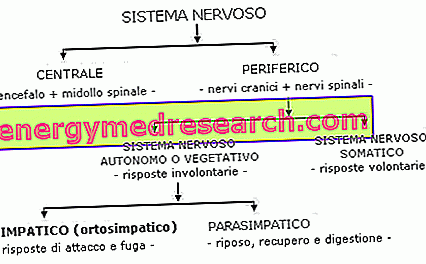The sympathetic (SNS) is one of two branches of the autonomic or vegetative nervous system (SNA), which intervenes in the control of involuntary bodily functions.

The sympathetic system has a stimulating, exciting, contracting function; as shown in the figure, he presides over the attack and escape adaptation system, preparing the body to face danger. A violent and unexpected noise in the dark, the scream of a friend jokingly appeared suddenly, are examples of stressful situations that lead to a massive activation of the sympathetic system. In a few moments the heart increases the strength and the contractile frequency, the bronchi, the pupil and the blood vessels of the appendicular and coronary system dilate, while at the liver level the glycogenolysis is stimulated. At the same time, again in order to prepare the body for impending physical activity, the digestive processes are significantly slowed down, while the cutaneous and peripheral blood vessels become constricted and the arterial pressure increases. The bladder relaxes, while the sphincter narrows (inhibits urination).

The nerves of the sympathetic system are distributed to the blood vessels, to the sweat glands, to the salivary glands, to the heart, to the lungs, to the intestine and to numerous other organs. Unlike what happens in the somatic nervous system (voluntary), the impulses of the vegetative system reach the viscera through two neurons, the first of which is located in the central nervous system and the second in the peripheral nervous system.

Some preganglionic fibers pass through the paravertebral ganglia without interruption and continue in splanchnic branches which lead from the sympathetic chain to the prevertebral ganglia (such as the mesenteric and the celiac) placed in front of the column.
From the paravertebral and prevertebral ganglia, the unmyelinated nerve fibers (axons) of the second neuron (postganglion) that reach the target organs depart.

Exceptions to this double neuron rule are the sympathetic fibers that innervate the adrenal medulla (in this case, there are no pre and post-ganglionic fibers but a single neuron).
The neurotransmitter characteristic of the sympathetic preganglionic neuron is acetylcholine, while the postglanglia neuron exploits norepinephrine and adrenaline (produced by adrenal medulla and stimulated by acetylcholine released by the only neuron): for this reason the sympathetic nervous system is known also as an adrenergic system.



